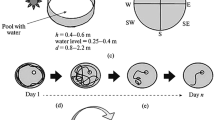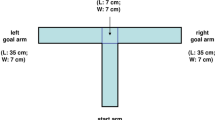Abstract
1. We developed a new kind of food search test that can measure murine nocturnal memory without handling hard work for setting up.
2. This apparatus has four food stations, but only one station had accessible food at any time. The one station with accessible food was changed at 4-h intervals.
3. We compared the performance of transient forebrain global Ischemic mice, which are a hippocampal lesion model, with the performance of control C57BL/6J mice.
4. The correct visit ratio, i.e., the ratio of the number of visits to the correct food station to the number of visits to all stations, gradually increased in the control mice, but did not change in the Ischemic mice.
5. This new system was demonstrated to be an additional and useful tool for studying memory-related performance in mice.
Similar content being viewed by others
References
Bures, J., Fenton, A. A., Kaminsky, Yu., and Zinyuk, L. (1997). Place cells and place navigation. Proc. Natl. Acad. Sci. U.S.A. 94:343–350.
Cahill, L., McGaugh, J. L., and Weinberger, N. M. (2001). The neurobiology of learning and memory: Some reminders to remember. Trends Neurosci. 24:578–581.
Cammarota, M., Bevilaqua, L. R. M., Viola, H., Kerr, D. S., Reichmann, B., Teixeira, V., Bulla, M., Izquierdo, I., and Medina, J. H. (2002). Participation of CaMKII in neuronal plasticity and memory formation. Cell. Mol. Neurobiol. 22:259–267.
Crawley, J. N. (1999). What's Wrong With My Mouse? Wiley, New York pp. 83–129.
Izquierdo, L. A., Barros, D. M., Vianna, M. R. M., Coitinho, A., Silva, T. D., Choi, H., Moletta, B., Medina, J. H., and Izquierdo, I. (2002). Molecular pharmacological dissection of short-and long-term memory Cell. Mol. Neurobiol. 22:269–287.
Kurokawa, M., Akino, K., and Kanda, K. (2000). A new apparatus for studying feeding and drinking in the mouse. Physiol. Behav. 70:105–112.
Lipp, H. P., and Wolfer, D. P. (1998) Genetically modified mice and cognition. Curr. Opin. Neurobiol. 8:272–280.
Milner, B., Squire, L. R., and Kandel, E. R. (1998). Cognitive neuroscience and the study of memory. Neuron 20:445–468.
Oades, R. D., and Isaacson, R. L. (1978) The development of food search behavior by rats—The effect of hippocampal damage and haloperidol. Behav. Biol. 24:327–337.
Ohtomo, N., and Tanaka, Y. (1994). Applications to medical and biological sciences. In Saito, K. (ed.), A Recent Advances in Time Series Analysis by Maximum Entropy Method: Applications to Medical and Biological Sciences, (Hokkaido University Press, Sapporo, Japan pp. 11–62.
Thompson, R. F., and Kim, L. J. (1996). Memory systems in the brain and localization of a memory. Proc. Natl. Acad. Sci. U.S.A. 93:13438–13444.
Von Bohlen, H. O., and Albrecht, D. (1998) Tracing of axonal connectivities in a combined slice preparation of rat brains—A study by rhodamine-dextran-amine-application in the lateral nucleus of the amygdala. J. Neurosci. Methods. 81:169–175.
Whishaw, I. Q., Sarna, J. R., and Pellis, S. M. (1998) Evidence for rodent-common and species-typical limb and digit use in eating, derived from a comparative analysis of ten rodent species. Behav. Brain Res. 96:79–91.
Wilson, M. A., and Tonegawa, S. (1997) Synaptic plasticity, place cells and spatial memory: Study with second generation knockouts. Trends Neurosci. 20:102–106.
Yang, G., Kitagawa, K., Matsushita, K., Mabuchi, T., Yagita, Y., Yanagihara, T., and Matsumoto, M. (1997). C57BL/6 strain is most susceptible to cerebral ischemia following bilateral common carotid occlusion among seven mouse strains: Selective neuronal death in the murine transient forebrain ischemia. Brain Res. 752:209–218.
Author information
Authors and Affiliations
Rights and permissions
About this article
Cite this article
Kurokawa, M., Fujimura, K. & Sakurai-Yamashita, Y. A New-Generation Apparatus for Studying Memory-Related Performance in Mice. Cell Mol Neurobiol 23, 121–129 (2003). https://doi.org/10.1023/A:1022956403708
Issue Date:
DOI: https://doi.org/10.1023/A:1022956403708




